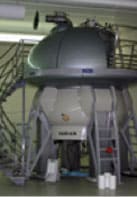Protein & Peptide BioNMR Discovery Services
SARomics Biostructures provides a wide range of custom peptide and protein NMR spectroscopy (BioNMR) analysis services for protein structure determination, fragment screening, and biosimilar comparability analysis.
Custom high-resolution protein NMR Services
SARomics Biostructures provides a wide range of custom peptide and protein NMR spectroscopy (BioNMR) analysis services for protein structure determination, fragment screening, and biosimilars comparability analysis. Below is a brief overview of the services.
- Peptide NMR & protein NMR assignment, secondary structure assessment
- Peptide NMR & protein NMR structure determination
- Protein-ligand & protein-protein complex structure determination
- Fragment screening using 1D or 2D NMR spectroscopy
- Epitope mapping and dissociation constant (Kd) determinations for compounds
- Biosimilars higher order structure (HOS) comparability analysis, formulation characterization, and optimization both by NMR spectroscopy and X-ray crystallography
- Expression and purification of 2H, 15N, and 13C-labelled protein in E.coli for NMR spectroscopy studies and structure determination
For details on the different service packages, please see below.
Our technology and methods center addresses common questions about the practical aspects of BioNMR experiments. It also provides and overview of various strategies used in structure-based drug discovery, which, among other methods, also include NMR spectroscopy. Feel free to reach out directly to discuss your project.

Protein NMR spectroscopy

NMR fragment screening

Biosimilars comparability analysis
Custom high-resolution NMR structure determination and analysis
Peptide or protein BioNMR is a powerful alternative to X-ray crystallography for determining and analyzing three-dimensional protein structures, especially for peptides, where crystallization is often impossible. Unlike X-ray crystallography, NMR spectroscopy analysis only requires the peptide or protein to be stable in solution to determine its structure. Typically, NMR can determine the structure of proteins up to 30 kDa in size. Our custom NMR structure determination services usually use iterative restrained molecular dynamic simulations with structural restraints generated from 2D and 3D NMR spectroscopy experiments.

Peptide and protein assignment and secondary structure analysis using NMR
In peptide or protein NMR spectroscopy structure analysis, the first step is to match the peaks detected in the NMR spectrum with individual atoms. This assignment is essential for determining the primary structure and assessing the secondary structure of peptides. It is also used for assigning 2D 15N NMR spectra in epitope mapping, fragment screening, and Kd determinations. Additionally, the assignment helps determine whether it is possible to determine the structure of a peptide or protein.

Custom protein-ligand/protein-protein complex NMR structure determination
The protein must be assigned to analyze the structure of protein complexes using BioNMR. If the individual components’ structures are unknown, it is still possible to determine the structure of the complex. Alternatively, available assignments and structures (from X-ray crystallography or protein NMR spectroscopy) can be combined with filtered NOESY experiments or transfer NOE experiments to analyze the complex. The protein should be labeled with 15N and 13C. Unlike X-ray crystallography, even complexes with binders having affinities in the µM-mM range can be analyzed, making it suitable for peptide-protein and protein-protein complexes.

NMR fragment and ligand screening
We conduct custom NMR fragment and ligand screening to validate drug-like compounds using our proprietary weak-affinity chromatography (WAC™) platform. This can be done independently or in combination with fragment screens. We can run 1D ligand-detection experiments or 2D spectra depending on the target protein. For 1D ligand detection, we can perform 1H or 19F experiments. We can identify potential binding sites by conducting competition experiments with a known binder. In 2D experiments, the protein must usually be labeled with 15N (or 2H for large proteins). However, recent advances in NMR technology enable us to conduct NMR fragment screening on non-isotope labeled samples by examining the methyl region of the 13C NMR spectrum. If the assignment is available, we can readily identify the binding epitope of various fragments at atomic resolution.

Epitope mapping and dissociation constant (Kd) determinations for compounds
The binding epitope of a compound can be thoroughly analyzed using BioNMR through 1D or 2D experiments. The choice between the two depends on the availability of isotope-labeled protein and peak assignments. For 1D experiments, ligand-detection NMR experiments in combination with competition experiments using a known binder can effectively identify the binding site of a compound. For 2D experiments, the binding site of a compound can be precisely identified at an atomic resolution if an assignment is available. However, even without an assignment, it is entirely feasible to identify the binding site if a known binder is available. Similarly, the dissociation constant (Kd) can be accurately determined using titration experiments detected by 1D or 2D NMR. No assignment is needed for Kd determinations in 2D experiments, although it is advantageous if atomic resolution is required.

Higher order structure (HOS) comparability analysis of biosimilars, comparability studies for formulation optimizations
NMR spectroscopy can be utilized to analyze the higher-order structure (HOS) of biosimilars and to compare their structure to the structure of the original antibody. For this purpose, 2D 13C NMR spectra of the methyl region of the biomolecule are obtained and used to compare the biosimilar and the original spectra. No labeling is necessary, and this method can be applied to large molecules such as whole antibodies. Additionally, the biomolecules can be studied in the formulation buffer for formulation optimization and batch comparison. Depending on the biomolecule, approximately 1-2 mg of protein can be adequate for HOS analysis. You can also read our blog post on why NMR spectroscopy is the best method for studying the comparability of biosimilars.
Please visit our services page for details on antibody structure determination by X-ray crystallography,

Expression and purification of 2H, 15N, and/or 13C-labelled protein in E.coli for NMR studies
To determine the structure of peptides and proteins using BioNMR, the protein must be labeled with 15N and 13C to analyze the 2D NMR spectra at an atomic level. This can be achieved by expressing the protein in E. coli using established protocols, where 15N-labeling is not significantly more expensive than standard E. coli expression. 15N-labeling is generally adequate for conducting 2D NMR fragment screening and confirming protein constructs’ folding status. Depending on the specific project, additional isotope labeling may be necessary, particularly for larger proteins, which often produce clearer NMR spectra when labeled with 2H.

Recent publications
Petruk G, Puthia P, Samsudin F, Petrlova J, Olm F, Mittendorfer M, Hyllén S, Edström D, Strömdahl A-C, Diehl C, Ekström S, Walse B, Kjellström S, Bond PJ, Lindstedt S & Schmidtchen A (2023).
Targeting Toll-like receptor-driven systemic inflammation by engineering an innate structural fold into drugs.
Nat Commun, 14, 6097. https://doi.org/10.1038/s41467-023-41702-y
PDB entries:
8BWW – Targeting Toll-like receptor-driven systemic inflammation by engineering an innate structural fold into drugs
Thrombin-derived C-terminal peptides (TCPs) are endogenous anti-infective immunomodulators interfering with CD14-mediated TLR-dependent immune responses. Using a combination of structure- and in silico-based design, nuclear magnetic resonance (NMR) spectroscopy, biophysics, mass spectrometry, cellular, and in vivo studies, the paper presents the structure, CD14 interactions, protease stability, transcriptome profiling, and therapeutic efficacy of sHVF18.

